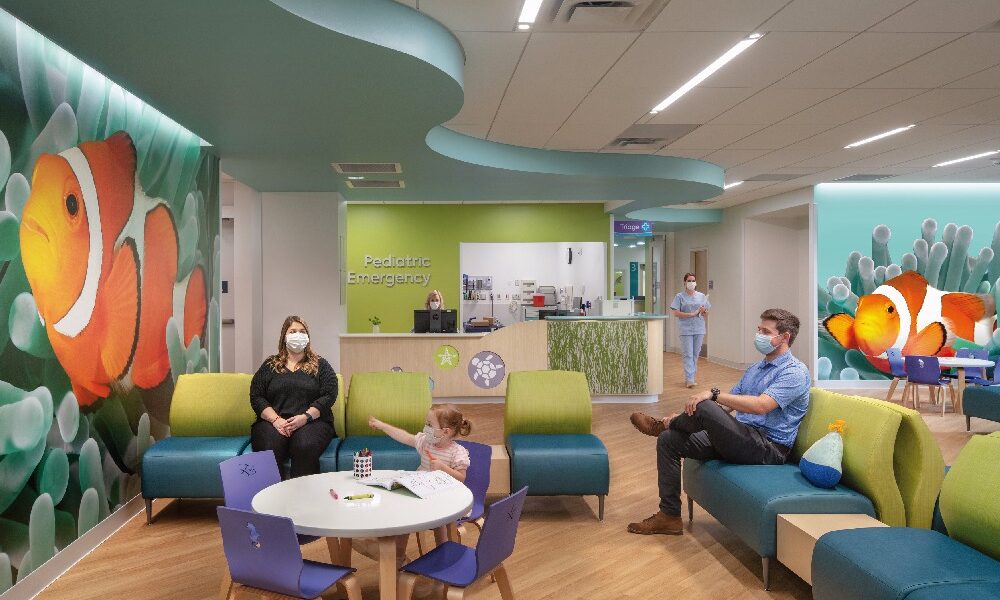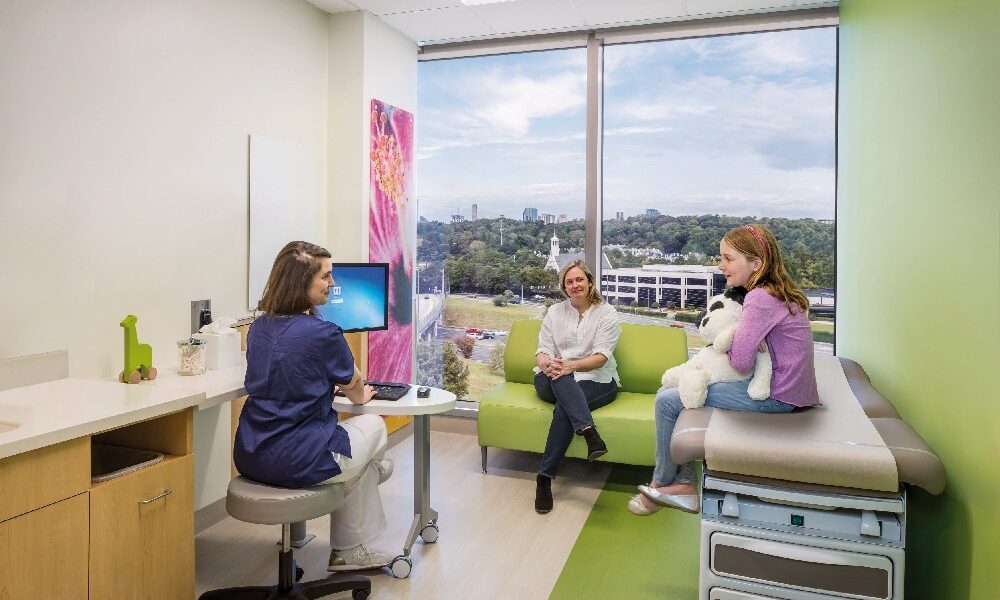 An aquatic theme winds through Wellstar Douglas Pediatric Emergency Department including the child-centered waiting area | Photography copyright: Jim Roof, Jim Roof Creative
An aquatic theme winds through Wellstar Douglas Pediatric Emergency Department including the child-centered waiting area | Photography copyright: Jim Roof, Jim Roof Creative  CHOA CAP pediatric exam room | Photographer: Jonathan Hillyer
CHOA CAP pediatric exam room | Photographer: Jonathan Hillyer Subscribe Now
Getting Personal
Healthcare architect, designers share how hospital experiences impact their work
After spending time in the hospital with her father, mother and husband, Annabella Koloskov, lead medical planner for Page, found herself even more appreciative of well-designed healthcare spaces. Yet, she constantly saw areas where care could be improved.
“Whether young or old, it is likely we will all be treated in a hospital at some point in our lives,” says Koloskov. “Good healthcare design is all about the experience.”
The following personal healthcare experiences by Koloskov and two colleagues illustrate how those experiences lent insight and perspective into their work.
Experience #1: Annabella Koloskov, senior medical planner
My father was a doctor with his own clinic serving the Hispanic community. I’d hang out with him, especially when I was in college since his clinic was right next to the University of Houston (Texas). He talked through cases with me, so I knew medical terminology from a young age.
Still, when my father had a diabetic crisis, he didn’t want to go to the hospital. His medical knowledge was a double-edged sword; what they say about doctors making the worst patients is true. It doesn’t matter who you are, when you are sick or someone you love is sick, you are scared.
Everyone needs a comforting, well-designed space when receiving medical care. That’s why clear wayfinding is so important in designing a facility that is easy to navigate and doesn’t add to the family’s stress.
Wayfinding starts even before the visit, with parking and office location sent to the patient’s smartphone or email, to oversized branding/logos on the building that can be seen by people driving by, to directional signage, to color coding of hallways or operational pathways, to memorable sculptures, lighting or art indicating elevator banks, main entrances and thoroughfares. The more intuitive the wayfinding, the better.
While at the hospital with my father, I watched and learned. When he had a stroke and had to get an MRI, he was scared because he was mildly claustrophobic. I only wish he’d been able to use the kind of MRI we now design, which feels more open and soothing and produces less anxiety.
Every time I’m in a medical space is a learning experience. I ask staff questions about the room and the placement of equipment. For instance, I’ll notice that nurses don’t have easy access to the medical gases on the headwall, which is usually behind the bed. That’s why we place them on the side of the bed for ease of access.
When my husband was diagnosed with primary biliary cholangitis, a liver disease caused by an autoimmune disorder, and needed a liver transplant, I was in shock. My time with him in the ICU taught me to be respectful when I go into a hospital as an architect. People may be in mourning, confused or in pain.
I was able to be in my husband’s room most of the time for the weeks leading up to his transplant. Later, when I was working on the design of a public hospital, I lobbied for family space in each room as a crucial part of patient- and family centered care.
Now we design private patient rooms with a family zone including a place to sleep, separate from the clinical space, so the family isn’t in the way of the medical staff. Flexibility is important, since the room has to serve patients of different ages, ailments and family situations.
My mother’s Alzheimer’s has given me additional perspective. She was first diagnosed with mild cognitive impairment. Then she fell and broke her arm and had to be admitted to the hospital. Fortunately, I was able to be there with her after surgery because she wasn’t eating and had lost her ability to communicate in English and could only speak Spanish. I was able to serve as her translator and health advocate, which is imperative, especially for older patients.
These experiences have given me a 360 degree perspective, adding to my library of knowledge.
Experience #2: Mezio Zangirolami, lead designer
As an adult who designs healthcare spaces for children, I am constantly channeling my inner child and getting to be a kid at heart. And as a parent, I know children learn best through play, so it’s important to scatter playful, interactive spaces throughout the environment. A button that makes music, for instance, or a window that transports you to another place.
Interactive tools and displays can teach children about healthy living. Mock MRI toys can show what to expect and make procedures less scary. Something as simple as metal bugs or animals inlaid in the terrazzo floor, or a pattern in the wall that hides icons waiting to be found by inquisitive eyes, can provide a sense of discovery and delight.
On one occasion I was with my own children visiting a specialist. They took off running, following the floor pattern that weaved in and out of the furniture like a ribbon, intended to highlight the path through the waiting room. Later, when I asked them what they liked best about the building, they proclaimed that flying down the path was the most fun but they did not like how, in a couple of cases, pieces of furniture had overlapped it. I thought to myself, this is why it’s important to coordinate all aspects of the design.
The art of positive distraction can’t be oversold: Color-changing lights that can be set to the child’s favorite hue. An imaging room that can be turned into an underwater fantasy, with moving projections. Play areas tailored to different ages, from toddlers to teens.
My daughter once got to wait in a prep room for her surgery that had a sensory element: a tall acrylic cylinder with bubbling water and colored lights. Not only did it reduce her anxiety, it calmed my wife and I, as well. These types of soothing features actually do improve the patient and family experience.
Young patients are empowered by even a modest amount of control over their experience, such as being able to adjust the lights or the blinds in their rooms. This suggestion often arises in family or youth focus groups or patient advisory councils.
The fun choice of riding in a wagon to the OR was enjoyed by my children when they underwent procedures, and I was amazed when each waved to me with a big smile as they headed back to the surgical suite. One didn’t even look back!
Healthcare facilities have multiple layers of complexity, from considerations of life safety and infection control to myriad clinical processes; pediatric design has its own set of requirements. But within these parameters lie opportunities for fun, discovery and imagination to flourish.
Experience #3: Kahtura Fernander, designer II
As a child, I would sometimes awake in the early morning hours to my older sister having a spasm attack. These attacks were terrifying. Alexzandria was 13 when we found out she had myasthenia gravis, an incurable neuromuscular and autoimmune disorder no one in the family had ever heard of. It’s a rare disease, and there were few resources for dealing with it where we grew up in The Bahamas.
There were only two available hospitals on the island, and no children’s-only hospitals. Seeing my sister go in and out of the least favorable, which had an atmosphere that was not conducive to young patients and where we had seen many lose their lives, was heartbreaking.
A typical visit with my sister went like this: We would go through security, which was pretty much nonexistent, and then my sister would be there in bed in a large room. She could look around and see everyone. There were older people around who were very sad to see, some were dying. To be a kid like that, it makes you afraid, ‘Am I going to die?’ The equipment was old and the room colors were a dull yellow. It was a depressing environment for a child.
One of her biggest struggles was attending school due to her illness. Some days we would be picked up at the end of the school day together; other days she might leave in an ambulance.
Fast forward: My sister is now in her 30s and a teacher, with a husband and two beautiful kids. Shan has survived open-heart surgery among other procedures but is doing much better. My family and I are grateful, and proud of how strong she continues to be.
Having gone through a serious and lifelong chronic disease with someone I love has made me passionate about designing healthcare projects, especially for children.
I help create a safe, nurturing environment for other young patients in need of help, with equipment designed for them, where pediatric patients and their families are at the center of their medical teams’ expert care and attention.
Designers specializing in pediatric hospitals create spaces that are bright from natural daylight through windows, colorful yet calm, filled with fun, interactive elements and engaging art. These spaces provide a place where sick children might still find a bit of happiness or joy. Play spaces to meet other children are important, but so is privacy, a place to feel secure and to be with family. Even the food is made to appeal to children’s eyes and appetites, so they may try it even when they aren’t very hungry.
My own family’s experiences have made me better able to communicate to healthcare clients when (and why) I feel something might need to be adjusted or changed in the design. I pay attention to the details clients provide, and if something doesn’t align with what I feel would improve the experience, I share my opinion, perhaps with a story or anecdote. They are in that environment all the time, so it’s good for them to get additional feedback from someone with a different perspective, one that is from the heart.
Author:
Content provided by Page, a multidisciplinary design, architecture and engineering firm.
Tags: hospital design, Page, Wayfinding
Posted February 15, 2023
More Articles:
- CxA Workshop & Exam
Apr 29, 2024 – Apr 30, 2024 - EMP Seminar & Exam at CxEnergy 2024
Apr 29, 2024 – Apr 30, 2024 - CxEnergy
Apr 29, 2024 – May 2, 2024 - PHCC West 2024
Apr 29, 2024 – May 2, 2024 - Lean in Design Forum 2024
May 1, 2024 – May 2, 2024 - IFMA’s Facility Fusion Conference & Expo
May 5, 2024 – May 7, 2024 - ASHE Academy 2024
May 6, 2024 – May 10, 2024










